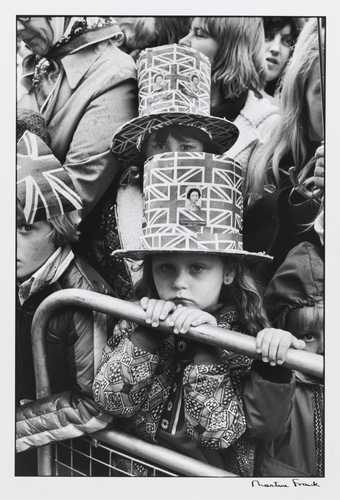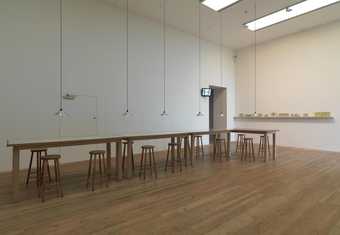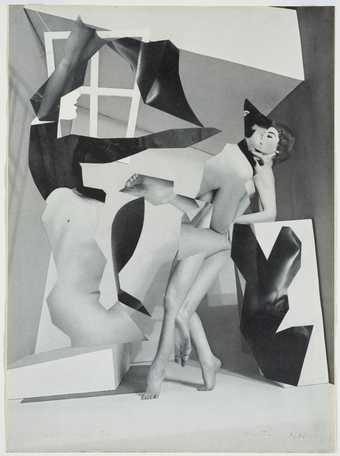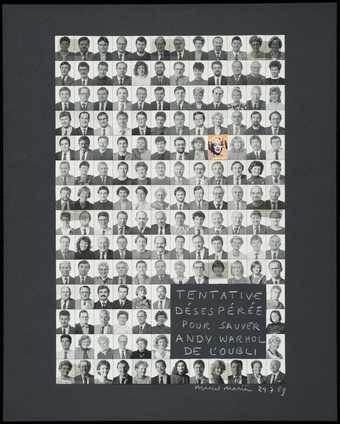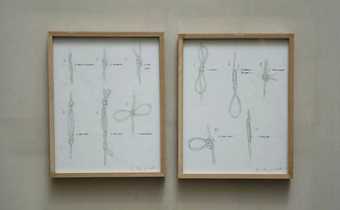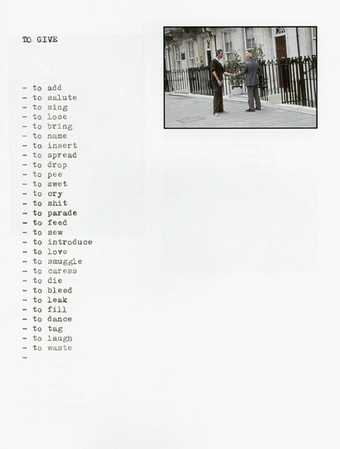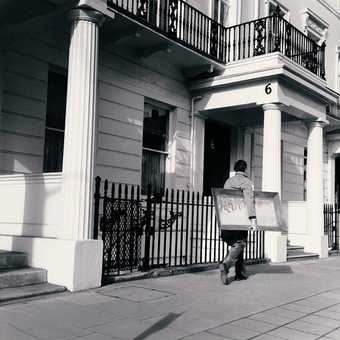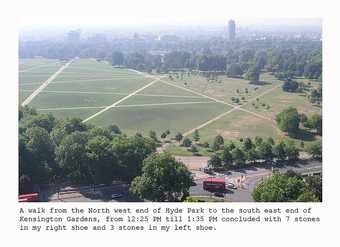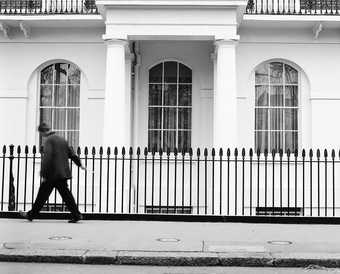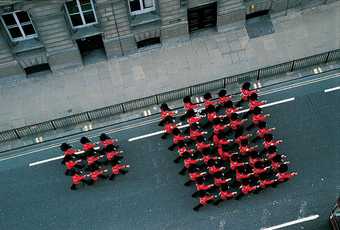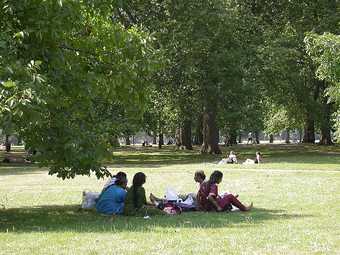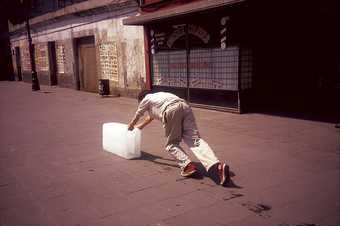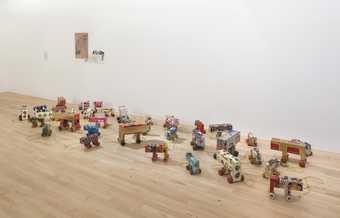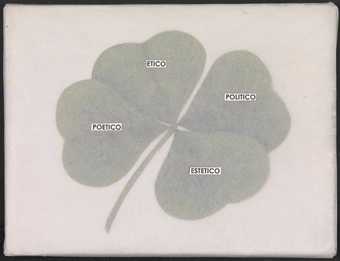
Not on display
- Artist
- Francis Alÿs born 1959
- Medium
- Video, 2 maps, printed papers, 7 drawings and book
- Dimensions
- Duration: 19 min
object: 2340 × 2840 × 600 mm
overall display dimensions variable - Collection
- Tate
- Acquisition
- Presented by Tate Patrons 2006. The Artangel Collection at Tate
- Reference
- T12195
Summary
The Nightwatch is a twenty-channel synched video installation displayed on Hanterex monitors, which are configured in a four-by-five arrangement. Each screen displays a static shot of a room within a deserted art gallery. Within these screens the only discernible movement is that of a fox, which wanders between the rooms, moving across the various screens. The fox periodically pauses to explore underneath the benches or rise up on its hind legs to sniff the paintings. The twenty videos play on a loop. The video can be shown as a standalone piece or installed alongside the maps, sketches and notebooks that Alÿs created while developing the work. When shown, this material is displayed in an adjacent vitrine.
The Nightwatch documents an action realised by Alÿs in 2004 in which he released a fox into London’s National Portrait Gallery in the middle of the night and used the museum’s CCTV system to follow its movements. The institution was chosen because unlike other institutions it does not conceal its CCTV cameras. The display of the resultant twenty-channel film of Alÿs’s action within a bank of monitors mimics the setup you might find in a security office, and places the viewer in the position of the security officer. Alÿs created this work after coming to London because he wanted to scrutinise the prevalence of surveillance within the city: ‘You may be used to it as a native to the city, but to a foreigner it’s quite shocking, especially when you come from a place like Mexico City … Apparently the average Londoner is filmed something like 300 times a day. That already says something about the relationship people in London have to the public sphere’ (Alÿs in 21 Portman Square 2005, p.26.)
The extensive research process that informed the action and resultant film is documented in the installation’s accompanying vitrine. The sketches, notebooks and maps overlaid with the artist’s handwritten annotations record the evolution of the work. Alÿs often integrates his preparatory material into his installations in order to deepen the viewer’s understanding of the work. The use of CCTV as a form for documenting an action was a new but welcome expansion of Alÿs’s practice:
Some of the maps we did while scouting the city were two parallel walks, one following the path of maximum surveillance, the ‘route of fame’, and another following the path of least resistance, the clandestine way. As an artist who works with performance, I am always struggling when it comes down to the documentation, how can one offer a neutral account of what happened, how can one disassociate the moment of the performance itself … The omnipresence of CCTV cameras in London offered a unique opportunity to actually have this neutral bank of footage of the performance.
(Alÿs in 21 Portman Square 2005, p.26.)
The Nightwatch is one of nine works in Tate’s collection from Alÿs’s series Seven Walks. The series was created over the course of six years, as Alÿs wandered the streets of London and mapped its habits, rhythms and rituals in a range of different media. In 2005 the resulting films, videos, paintings, photographs and drawings became Seven Walks; works which either documented the artist’s own walks or those enacted by others on his behalf. The art critic Coline Milliard has stressed how the series humanises the city in which it was made:
Alÿs’s walking creates a ground-level image of the city, fragmented, subjective and incomplete. It claims space for the fragile, the ephemeral and the poetic. In a commuter city where pedestrianism fights for survival, ‘Seven Walks’ transforms increasingly alienating surroundings into a new space tailored to human dimensions.
(Milliard 2010, p.4.)
Alÿs has used walking as an impetus for his work throughout his career, including in early pieces such as The Last Clown 1995–2000 (Tate T07993) and Pebble Walk 1999 (Tate T12193). Other works in the Seven Walks series include Sunny/Shady 2004 (Tate T12197) and Railings 2004 (Tate T12194).
An edition of the single-screen version of The Nightwatch also exists, but the work in Tate’s collection is a unique twenty-channel version.
Further reading
Francis Alÿs: Seven Walks, London 2004–5, exhibition catalogue, 21 Portman Square, London 2005.
Nicholas Whybrown, Art and the City, London 2010.
Coline Milliard, ‘Walks of Life’, Art Monthly, vol.337, June 2010, pp.1–4.
Phoebe Roberts
March 2016
Does this text contain inaccurate information or language that you feel we should improve or change? We would like to hear from you.
Display caption
Francis Alÿs’ The Nightwatch was made by releasing a fox into London’s National Portrait Gallery and following its movement through the galleries using the museum’s CCTV system. The installation itself mimics the wall of monitors in a surveillance station. Alÿs was inspired partly by the proliferation of surveillance cameras around London, and by the number of urban foxes forced to lead a scavenger existence in the city.
Gallery label, July 2010
Does this text contain inaccurate information or language that you feel we should improve or change? We would like to hear from you.
Explore
- architecture(30,960)
-
- garden structures(1,939)
-
- park(320)
- emotions and human qualities(5,345)
-
- anxiety(1,028)
- documentary(1,026)
- photographic(4,673)
- public and municipal(956)
-
- museum(61)
- frame(64)
- UK countries and regions(24,355)
-
- England(19,202)
- social comment(6,584)
-
- surveillance(1)
You might like
-
Johan Grimonprez Dial H-I-S-T-O-R-Y Inflight
1997–2001 -
Martine Franck Greenwich, London
1977 -
Francis Alÿs The Last Clown
1995–2000 -
Marcel Mariën Sculpture Friends
1974 -
Marcel Mariën Desperate Attempt to Save Andy Warhol from Oblivion
1989 -
Francis Alÿs Knots
2005 -
Francis Alÿs The Commuters
2005 -
Francis Alÿs Pebble Walk
1999 -
Francis Alÿs Railings
2004 -
Francis Alÿs Guards
2004 -
Francis Alÿs Sunny/Shady
2004 -
Francis Alÿs Ice 4 Milk
2004–5 -
Francis Alÿs Collectors
2006 -
Francis Alÿs Untitled
2000–10


